We consider the coalition formation games with an additional component, `noisy preferences'. Moreover, such noisy preferences are available only for a sample of coalitions. We propose a multiplicative noise model and obtain the prediction probability, defined as the probability that the estimated PAC core-stable partition of the noisy game is also PAC core-stable for the unknown noise-free game. This prediction probability depends on the probability of a combinatorial construct called an `agreement event'. We explicitly obtain the agreement probability for $n$ agent noisy game with l\geq 2 support noise distribution. For a user-given satisfaction value on this probability, we identify the noise regimes for which an estimated partition is noise robust; that is, it is PAC core-stable in both noisy and noise-free games. We obtain similar robustness results when the estimated partition is not PAC core-stable. These noise regimes correspond to the level sets of the agreement probability function and are non-convex sets. Moreover, an important fact is that the prediction probability can be high even if high noise values occur with a high probability. Further, for a class of top-responsive hedonic games, we obtain the bounds on the extra noisy samples required to get noise robustness with a user-given satisfaction value. We completely solve the noise robustness problem of a $2$ agent hedonic game. In particular, we obtain the prediction probability function for l=2 and l=3 noise support cases. For l=2, the prediction probability is convex in noise probability, but the noise robust regime is non-convex. Its minimum value, called the safety value, is 0.62; so, below 0.62, the noise robust regime is the entire probability simplex. However, for l \geq 3, the prediction probability is non-convex; so, the safety value is the global minima of a non-convex function and is computationally hard.
翻译:我们考虑的是带有附加组件的联盟构建游戏, “ 噪音偏好 ” 。 此外, 这种噪音偏好只能用于联盟的样本。 我们提议了一个倍增噪声模型, 并获得预测概率。 我们提议了一个倍增噪声模型, 其定义是: 噪音游戏的PAC核心稳定分配估计值对于未知的无噪音游戏来说也是PAC核心。 这种预测概率取决于组合构建一个称为“ 协议事件” 的概率。 我们明确获得了美元代理商以 l\geq 2 支持噪声分布来进行响动的概率。 对于此概率的用户赋予的不满意度值来说, 我们确定了一个预测性机制, 估计PAC 核心稳定在噪音游戏和无噪音游戏中的位置。 当估计的偏差不是 PACC 核心。 这些噪音制度与协议概率函数的等级相对一致, 并且对于螺旋2 来说, 一个重要事实是, 预测的概率可以很高, 但是如果以很高的概率发生的话, 我们就可以确定一个不精确度的数值。 更进一步,, 一个具有精确的预估测的游戏的概率, 。



